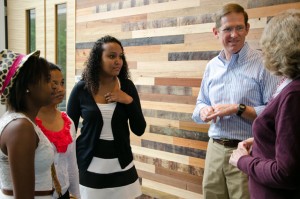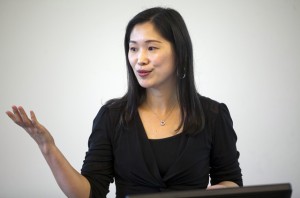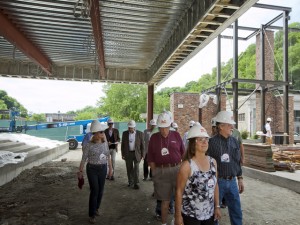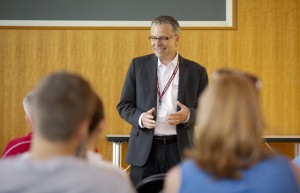By Geoff Gehman ’80
Three special events during Reunion 2015 gave alumni the chance to tour and learn about buildings and programs made possible by the “Live Connected, Lead Change” $400 million capital campaign.
New center, new approaches to global studies
At the new Oechsle Center for Global Education, Teevrat Garg ’10 and Sam Derrick ’10 outlined the goals of the Lafayette Initiative for Malagasy Education, which they helped start five years ago under the direction of David Stifel, professor of economics and chair of international affairs. The peer-mentoring program they devised helps Malagasy high school students navigate the daunting process of applying to U.S. colleges and universities by sending Lafayette students and faculty mentors to the island nation each year during the January interim for three weeks.

Professor David Stifel speaks with current and former members of Lafayette Initiative for Malagasy Education in the new Oechsle Center for Global Education. The wooden panels behind him are featured throughout the building and use salvaged lumber from around the world.
The wooden panels behind him are featured throughout the building and use salvaged lumber from around the world.
“They have limited exposure to the process,” says Garg of Malagasy students. “As an international student from India, I had a ton of information available.” That’s not the case in Madagascar, where five years ago less than 40 students were studying at U.S. institutions.
Listening to the presentation in Oechsle, Irv Kunzman ’57, a retired software engineer, was “awed” by the LIME team that helped Malagasy students prepare for the SAT and the Test of English as a Foreign Language, fill out admission forms, and practice English, a third language for most students behind Malagasy and French.
So far, three Malagasy students are enrolled at Lafayette and another will attend this fall.
Madagascar is only 900-odd miles from Malawi, where Kunzman spent five years as a spiritual ambassador. He taught management to African pastors and helped raise $25,000 for famine relief.
Like Kunzman, Ed Auble ’61 was impressed by a panoramic presentation from Seo-Hyun Park, assistant professor of government and law. She spoke of leading a groundbreaking 2011 interim trip to North Korea, where students encountered everything from anti-American propaganda in a war museum to Disney-loving subway riders eager to practice their English. The foreign exchange was a far cry from Auble’s experience at Lafayette, where he can’t remember meeting a foreign undergraduate.

Professor Seo-Hyun Park explains multiple approaches to global education.
Auble’s international career began as a Navy pilot in Vietnam. His training continued as an insurance broker in six countries, including Saudi Arabia. Today, he’s one of Lafayette’s most global volunteer leaders. He helped plan the Oechsle Center and helped launch the Class of 1961 International Affairs Speakers Series. He also chairs the International Alumni Committee.
Auble and Kunzman are bullish on the capital campaign’s $70 million goal for innovative teaching and learning. Kunzman wants to boost Lafayette’s booming study-abroad program; in 2015 international affairs students alone visited 31 countries. Auble wants to raise the IA Speakers Series fund from nearly $200,000 to $500,000.
Expanding the arts campus
Jack Kille ’65 and his wife Camille Kille ’89 stood in the Williams Visual Arts Building, listening to an explanation of fused deposition modeling, also known as 3D printing. Adam MacHose, technology coordinator of the Williams Arts Campus, guided the couple through a process that includes virtual sculpting software, a plastic used for LEGOs, dissolvable scaffolding, and a printer that could be mistaken for a see-through refrigerated kiln.
Kille, a retired developmental biologist, imagined using the machine to make models of fetuses to teach how growth in the womb is impaired by drugs and food additives.

Alumni take a guided hard-hat tour of the future Black Box Theater in the Williams Arts Campus.
The Killes like Lafayette enough to list it in their wills. They want to build a house in Forks Township so they can attend more College classes and events. On Friday they took a hard-hat tour of a place they expect to frequent: a film & media studies and theater building scheduled to open next year. It will anchor the Williams Arts Campus, which is designated for $20 million of capital campaign funds.
Sharing the hard-hat tour was Bob Singer ’65, who said he would like capital funds directed to financial aid. The attorney received money to attend Lafayette. He also attends classes with economically needy first-generation immigrants at the Newark branch of Rutgers University, widely acknowledged as America’s most international campus.
Financial aid concerns Roswell Barnes Jr. ’50, who toured the building with his daughter Melissa Barnes Skorupka ’84. Barnes said his Lafayette education, all $3,300 of it, was financed by his parents, including his father, Roswell Barnes ’24. Retired as a physicist, he insists he would return to work to help his grandchildren pay for the two years of college they can’t afford.
For decades Barnes has been giving Lafayette $1,000 a year. He knows at least 50 members of his class who have been donating the same amount over the same period of time. “The big guys,” he says, “appreciate the fact that the smaller guys support the College by setting the table.”
Integrating liberal arts and engineering
Fred Kaiser ’55 P’89 attended a talk in the Gendebien Room of Skillman Library about a new program aimed at turning engineers into cross-curricular entrepreneurs. The retired chemical engineer for Exxon was intrigued by the proposals of Scott Hummel, Jeffers Director of the Engineering Division and coordinator of the X-Trained Engineering Initiative, seeded by a $223,000 grant from the Kern Family Foundation. Hummel envisions developing skills not associated with engineers, especially working with non-engineers to make things that actually improve lives.

Professor Scott Hummel discusses the College’s new X-Trained Engineering Initiative.
Dan Sabatino, assistant professor of mechanical engineering, then described an experimental project backed by the x-trained initiative. His students plan to study modular analog synthesizers, ’70s dinosaurs back in vogue largely because musicians find them more interactive and creative than computers.
A potential problem with this process was posed by Kaiser, who helped clean up the Exxon Valdez’s 1989 oil spill in Alaska. Revolutionary visions, he pointed out, could be sabotaged by bosses who reject the visions as impractical, expensive, or radical. “I’ve seen many people damage their careers,” he added, “by trying to push a great idea.”
The synthesizer project appealed to Don Suberrac ’70, a retired mechanical engineer who helped electrify rural areas for the U.S. Department of Agriculture and helped build a Veterans Affairs outpatient clinic. He thinks analog records sound warmer and deeper than digital records, that CDs are pale imitations of vinyl albums.
Suberrac and Kaiser are loyal Lafayette donors. The former supports the mechanical engineering program; the latter the Annual Fund. They’re both interested in the campaign initiative to build a $70 million integrated sciences building that may include the Center for Innovation, Design, Entrepreneurship, and Leadership (IDEAL).
A committee headed by Provost Abu Rizvi is working on the plan regarding which academic departments and programs will be housed in the new building. The building is being made possible in part by a $27.9 million gift from Trustee Kent Rockwell ’66, given to support initiatives in science, technology, and innovation.



